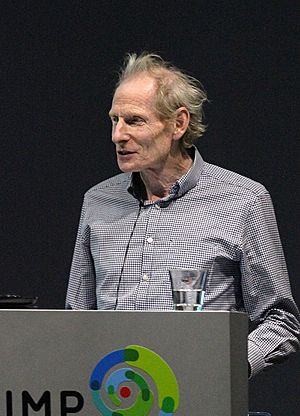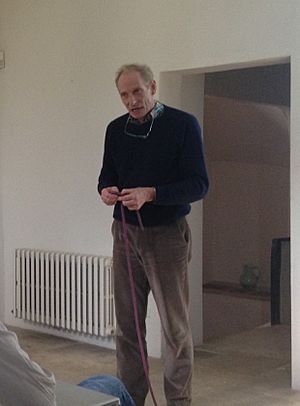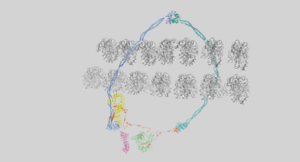Kim Nasmyth facts for kids
Quick facts for kids
Kim Nasmyth
FRS FMedSci
|
|
|---|---|

Nasmyth in 2017
|
|
| Born |
Kim Ashley Nasmyth
10 October 1952 |
| Nationality | British |
| Education | Eton College |
| Alma mater |
|
| Known for | Cohesin |
| Spouse(s) |
Anna Dowson
(m. 1982) |
| Children | Two |
| Awards |
|
| Scientific career | |
| Fields | molecular biology, gene regulation, cell cycle control |
| Institutions |
|
| Thesis | DNA replication in Schizosaccharomyces pombe (1977) |
| Doctoral advisor | Murdoch Mitchison |
| Notable students |
|
Kim Ashley Nasmyth (born 18 October 1952) is an English scientist who studies genetics. He is famous for his work on how chromosomes separate when a cell divides. This is a very important process for all living things, including humans.
His discoveries have helped us understand how our bodies grow and stay healthy. He worked as a professor at the University of Oxford and was the director of the Research Institute of Molecular Pathology (IMP) in Austria.
Contents
Early Life and Schooling
Kim Nasmyth was born in London, England, in 1952. His father, Jan Nasmyth, was a successful businessman who founded a large company called Argus Media.
Nasmyth went to Eton College and later studied Biology at the University of York. For his advanced studies, called a PhD, he went to the University of Edinburgh. There, he worked with a scientist named Murdoch Mitchison.
His research focused on how DNA copies itself in a type of yeast called fission yeast. Scientists often study simple organisms like yeast to learn about processes that also happen in human cells.
Scientific Career and Discoveries
After finishing his PhD, Nasmyth moved to Seattle in the United States for more research. There, he learned new ways to find and copy genes in yeast. This work helped him and another scientist clone an important gene called CDC28, which helps control when a cell divides.
Studying Genes in Cambridge
Later, as a research leader in Cambridge, England, Nasmyth became interested in how yeast cells can switch their "mating type," which is similar to changing gender. He discovered that yeast has "silent" copies of genes that are turned off.
This was a big deal because it was one of the first times scientists saw that a gene's location on a chromosome could affect whether it was on or off. This is called the position effect.
Major Breakthroughs in Vienna
In 1986, Nasmyth was invited to work at the new Research Institute of Molecular Pathology (IMP) in Vienna, Austria. There, he returned to studying the cell cycle, which is the life of a cell from one division to the next.
In the mid-1990s, his team made two huge discoveries:
- They found a group of proteins called the Anaphase-promoting complex (APC/C). This complex acts like a switch that tells a cell it's time for the chromosomes to separate.
- They discovered the genes for a protein complex called cohesin. Nasmyth showed that cohesin acts like a molecular glue, forming a ring that holds copied chromosomes together.
This was a major step in understanding how cells make sure that when they divide, each new cell gets a perfect copy of the DNA. He figured out that another protein, called separase, cuts the cohesin ring to release the chromosomes at just the right moment.
Work at Oxford University
In 2006, Nasmyth became the head of the Department of Biochemistry at the University of Oxford. He continued to lead a research group there, studying how cells work. He retired from research in 2022.
Awards and Honors
Nasmyth has won many important awards for his scientific work. These awards recognize his major contributions to our understanding of biology.
- 1985 Member of the European Molecular Biology Organization
- 1989 Elected a Fellow of the Royal Society
- 1995 FEBS Silver Medal
- 1996 Unilever Science prize
- 1997 Louis-Jeantet Prize for Medicine
- 1999 Wittgenstein-Preis
- 1999 Foreign Honorary Member of the American Academy of Arts and Sciences
- 2002 Croonian lecture/Medal of the Royal Society
- 2003 Boveri award for Molecular Cancer Genetics
- 2007 Gairdner Foundation International Award
- 2009 Elected a Fellow of the Academy of Medical Sciences (FMedSci)
- 2018 Breakthrough Prize in Life Sciences
Personal Life
In 1982, Nasmyth married Anna Dowson. They have two daughters. His younger brother, Luke Hughes, is a furniture designer.
Nasmyth enjoys hobbies like skiing and climbing. He has said that thinking about climbing helped him come up with his idea of how the cohesin ring works. He also co-owns a vineyard in the south of France.



